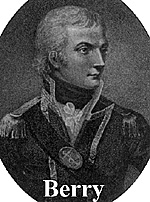 After a storm blew the British blockading ships away from the French ports, the armada got its opportunity to escape from Toulon and Marseille.
After a storm blew the British blockading ships away from the French ports, the armada got its opportunity to escape from Toulon and Marseille.
Edward Berry was captain of Nelson's flagship Vanguard. The unlucky Berry would be captured after the battle by one of the French ships that escaped.
The French ships navigated close to the coast and made a rendezvous on 21 May with the force that had left from Genoa, Italy. Then the armada headed for Corsica and joined with another French fleet there. Brueys waited near Corsica for the fourth and last element of the French expeditionary fleet that left from Civita Vecchia near Rome.
However, the ships carrying General Desaix's division from Italy missed this final rendezvous and sailed on to Malta, arriving there two days before the rest of Napoleon's armada.
This minor miscue had no adverse impact on French operations.
... Nelson's goal was the
total annihilation of
the enemy's forces.
British Admiral Jervis was commander of the British forces in the Mediterranean, but his subordinate, Rear Admiral Horatio Nelson was the man chosen to pursue the French armada. Nelson can rightfully be called the first modern naval officer. Unlike most of his contemporaries, French or British, Nelson rejected the view that naval battles were complete when honor had been satisfied. Rather, Nelson's goal was the total annihilation of the enemy's forces.
Nelson had come to the public's attention in February 1797 at the Battle of Cape St. Vincent where a British fleet of 15 ships, under the command of Admiral Jervis, fell upon 26 Spanish ships of the line. Without express permission, then Commodore Nelson in the ship Captain left the line of battle to prevent one division of the Spanish fleet from joining the other division. If the Spanish had been able to form a line of battle their ships could have decimated the outnumbered British ships.
The Captain, a two-decker of 74 guns, faced six Spanish ships, most of which were three-deckers having more than 100 guns each. Other British ships quickly came up in support, and the Spaniards were unable to carry out their maneuver. When the action ended, four ships had been taken, two by Nelson in the battered Captain.
Following this success, Nelson was promoted to Rear Admiral and given command in July of an expedition to capture a Spanish treasure ship at Santa Cruz. This first independent command was an unqualified disaster. Nelson, never one to stay behind when the shooting started, was wounded as he jumped ashore, and lost an arm. More importantly, Nelson lost prestige and, just possibly, some confidence in himself. Thus, when Nelson was given another opportunity in April 1798, this time to enter the Mediterranean in pursuit of Napoleon, he was extremely anxious to succeed.
The pursuit did not begin well. Nelson and his ships were caught and battered in a storm at about the same time Napoleon and his armada sailed for Egypt. Nelson's flagship Vanguard was nearly lost, and valuable time was spent repairing his ship at sea. More importantly, Nelson's frigates were gone -- returned to Gibraltar under the mistaken notion that Nelson would also return there for repairs. The small, fast frigates were Nelson's "eyes and ears" and would not join him until after the Battle of the Nile. With his ability to search severely curtailed, Nelson could only find the French if the two fleets blundered into each other at sea, or if Nelson were able to anticipate Napoleon's arrival in a port.
More Battle of the Nile 1798
-
Battle of the Nile 1798: Introduction
Battle of the Nile 1798: French and British Navies
Battle of the Nile 1798: French Luck and British Pursuit
Battle of the Nile 1798: French Success and British Frustration
Battle of the Nile 1798: Battle of Aboukir Bay
Battle of the Nile 1798: British Campaign Medal
Battle of the Nile 1798: French and British Order of Battle
Battle of the Nile 1798: Large Voyage and Pursuit Maps (very slow: 386K)
Battle of the Nile 1798: Large Battle Maps (very slow: 336K)
Battle of the Nile 1798: Jumbo Battle Maps (extremely slow: 562K)
Back to Table of Contents -- Napoleon #13
Back to Napoleon List of Issues
Back to MagWeb Master Magazine List
© Copyright 1998 by Napoleon LLC.
This article appears in MagWeb (Magazine Web) on the Internet World Wide Web.
The full text and graphics from other military history magazines and gaming magazines are available at http://www.magweb.com
Order Napoleon magazine direct